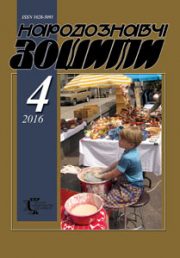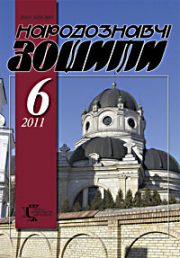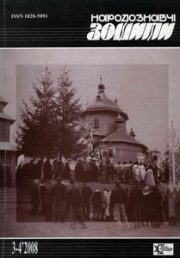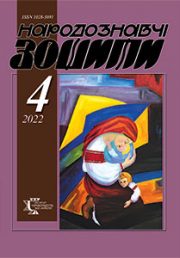The Ethnology Notebooks. 2023. № 6 (174), 1416—1423
UDK 036″19″:94(477.83-25)]:94(477+438)”18/19″(092)
DOI https://doi.org/10.15407/nz2023.06.1416
BOGDAN JANUSH‘S TWO GUIDES TO LVIV
MOVNA Marianna
- ORCID: http://orcid.org/0000-0003-2473-6998
- Ph. D. of Historical Sciences,
- Researcher of the Vasyl Stefanyk
- National Scientific Library of Ukraine of Lviv
- National Academy of Sciences of Ukraine,
- in Department of Scientific Bibliography,
- 2, Stefanyka str., 79000, Lviv, Ukraine,
- Contacts: e-mail: mari3anna@ukr.net
Abstract. The article is devoted to a comprehensive analysis of two guidebooks by the same author (B. Janush’s) — the Ukrainian-language handwritten (1919) and the Polish-language printed (1922) versions, which differ significantly in terms of tasks, content and presentation style of factual material. The handwritten guidebook represents the Ukrainian vision of Lviv. Janush focuses attention on the undeservedly belittled Ukrainian artifacts of Lviv and their national sound, so his guide introduces the interested reader to Ukrainian institutions and public organizations of Lviv that show its Ukrainian face. Special attention was paid to the historical center of Ukrainianism in the city — Ruska Street with the Volos’ka Church, the arch-cathedral of St. Yura, churches of St. Spirit, St. Peter and Paul, the Transfiguration of the Lord, to national societies and enterprises. The printed guide had a completely different goal — to provide mostly practical and concise information for residents and guests of the city. Describing the historical monuments in the city and paying considerable attention to Ukrainian ones among them, the author nevertheless does not emphasize their ethnic and religious affiliation, does not specifically single out Ukrainian objects, but provides information in the general historical and urban context. Studying these guides, which are valuable documentary evidence of the era, reveals a wide historical panorama of the city.
The subject of the research is two guidebooks by B. Janush, and the object is Lviv on their pages.
The research methodology is based on the application of the principles of scientificity, objectivity and historicism, and in the process of studying the material, problem-chronological and typological methods, the method of historical reconstruction and biographical studies were used.
Keywords: guidebook, Lviv, B. Janush, Ukrainian manuscript, Polish book edition, beginning of the 20th century.
Received 17.11.2023
REFERENCES
- (1930, 6 November). The tragic death of a Lviv scholar. Wiek Nowy, 8816, 6 [in Polish].
- (1930, 6 November). The tragic suicide of a scientist. Lwowski Kurjer Poranny, 332, 2 [in Polish].
- Burchard, H. (1964). Janusz Bohdan. Polish Biographical Dictionary, 47 (Vol. X/4, p. 587). Wroclaw; Warsaw; Krakow [in Polish].
- Krypyakevych, I. (1930, 7 November). Bohdan Janush: (posthumous mention). Dilo, 249, 4 [in Ukrainian].
- Movna, M. (2014). Guidebooks to Lviv (second half of the 19th — beginning of the 21st centuries): historical and cultural study. Lviv [in Ukrainian].
- Shah, S. (2006). Lviv — the city of my youth: a memory dedicated to the Shadows of forgotten Lviv residents (Part 1—2). Lviv [in Ukrainian].
- (1907). Meetings of sections. Chronicle of the Shevchenko Scientific Society in Lviv. Report for the months: September-December (Issue 4 (32), p. 9). Lviv [in Ukrainian].
- Petegyrich, V.M., & Ilnytska, L.I. (Ed.). (1996). The fate of the archaeological collection of the Museum of the National Academy of Sciences. Library of the Scientific Society named after Shevchenko: books and people: materials for the round table (Pp. 59—67). LNB named after V. Stefanyka [in Ukrainian].
- Janusz, B. (1909). From Russian museums in Lviv. Museum of the Scientific Society of Shevchenko. Na ziemi naszej, 17, 3—5 [in Polish].
- (1926, 23 November). Guide course in Lviv. Wywiad Codzienny, 29, 7 [in Polish].
- Janusz, Bohdan. (1914, February 7). Review. Ziemia, 7, 94—95 [in Polish].
- Janusz, Bohdan. (1926, November 23). Science. Wywiad Codzienny, 29, 7 [in Polish].
- [2005]. Janusz Bohdan. Encyclopedia of the Borderlands (P. 165). Krakow [in Polish].
- Svarnyk, I. (2006). Bohdan Janush: historian, conservator of prehistoric monuments of Eastern Galicia. Sights of Ukraine, 3/4, 111—115 [in Ukrainian].
- Golubets, M. (1930, 11 November). Over the grave of Bohdan Janush: (farewell speech). Dilo, 251, 4 [in Ukrainian].
- (1931, January-February). S. Mr. Bohdan Janusz. Z otchlani wiekow, 1, 13 [in Polish].
- Lemko, I., Mykhalyk, V., & Beglyarov, G. (2009). 1243 Lviv Street (1939—2009). Lviv [in Ukrainian].
- Karpovych, Vasyl. Guide to Lviv dates 1919, Lviv. Center State Archive of Ukraine in Lviv. F. 309 (NTSh). Op. 1. File 1418 [in Ukrainian].
- Janusz, B. (1922). Guide to Lviv. Lviv [in Ukrainian].
- Pappe, F. (1894). Outline history of the city of Lviv. Lviv [in Ukrainian].
- Charewiczowa, L. (1938). Historiography and love of Lviv. Lviv [in Ukrainian].







